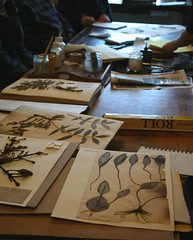Pressing Plants and Flowers Supports Nature-Based Learning through the Generations
Creative documenting of summer blooms capture memories and learning

Herbariums are collections of preserved plants and are fun ways for families to preserve summer memories while supporting an interest in botany and local habitats.
As the many flowering plants of the summer grow buds, burst into bloom, and fall to the ground to make way for the next wave of plants to come into season, children often collect specimens of their favorite colorful plants in an attempt to preserve them for endless enjoyment and examination. Inevitably, flowers in a vase will wilt, but carefully pressed and preserved plants can maintain a version of favorite plants that can be enjoyed and examined no matter the season. Pressed plants and flowers can be used for a variety of purposes, and lend themselves in particular to art projects and scientific observations. When compiled as a collection, pressed flowers can serve as a family herbarium – serving as documentation of springs and summers past.
There are a variety of techniques for pressing plants and flowers, the simplest of which requires only a sizable chapter book. Flowers carefully placed amongst the pages of a book will dry out and flatten, but may stain the book’s pages and will be very fragile once removed from the book. To press flowers and leaves in larger quantities than the average chapter book will allow (and with better results), build your own press using a few pieces of wood, screws, paper towels, and corrugated cardboard (as well as some basic power tool skills). Once flattened and dried, flowers can be further preserved using sturdy, acid-free paper and either plant-safe glue or a needle and thread. In addition to preserving flowers, families can use simple but specific techniques to dry and preserve succulents or favorite fruits and vegetables.
A summer filled with plant drying and preserving is a great way to build fodder for an herbarium. Used as a resource for learning about plants, herbaria include not only plant specimens but basic information about the place and time where plants were found. A family herbarium could serve as a resource for learning about the time of year when particular plants appear or bloom, and can also support children in learning to identify parts of plants and in recognizing the characteristics that set one plant apart from another. Try sorting, classifying, and categorizing your specimens as a family – even if children don’t sort according to the scientific criteria for identifying plants, sorting activities challenge children to think critically and to make specific observations about the items that they sort. Such close observation inevitable leads to learning!
In addition to being resource for learning about plants during any time of year, a family herbarium could serve as a plant-based memory book. When cataloging your collection, add not only the place where each plant was found, but details about the family adventure that lead to its discovery. Pages can be created to remember specific trips, hikes, and other adventures, and the dried plants and flowers will be well-preserved as nature treasures, lasting for years and years when properly treated. Visit our archived post on journal making to find resources for compiling and creating homemade books. Imagine how wonderful it will be to look back at a family herbarium when children are older – not only will they remember the fun that they had exploring a stream one July, but they’ll remember learning about the plants that surrounded them at the time, and they’ll remember connecting with the landscape in a way that they otherwise may not have.
Photo credit: Jenny Neal (herbariums)
 Hilltown Families
Hilltown Families 




























